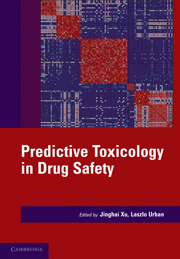Book contents
- Frontmatter
- Contents
- Contributors
- Prologue – Predictive toxicology: a new chapter in drug safety evaluation
- PREDICTIVE TOXICOLOGY IN DRUG SAFETY
- I SPECIFIC AREAS OF PREDICTIVE TOXICOLOGY
- II INTEGRATED APPROACHES OF PREDICTIVE TOXICOLOGY
- 10 Integrated approaches to lead optimization: improving the therapeutic index
- 11 Predictive toxicology approaches for small molecule oncology drugs
- 12 Mechanism-based toxicity studies for drug development
- 13 Fish embryos as alternative models for drug safety evaluation
- 14 The role of genetically modified mouse models in predictive toxicology
- 15 Toxicogenomic and pathway analysis
- 16 Drug safety biomarkers
- 17 Application of TK/PD modeling in predicting dose-limiting toxicity
- 18 Prediction of therapeutic index of antibody-based therapeutics: mathematical modeling approaches
- 19 Vaccine toxicology: nonclinical predictive strategies
- Epilogue
- Index
- Plate section
- References
16 - Drug safety biomarkers
from II - INTEGRATED APPROACHES OF PREDICTIVE TOXICOLOGY
Published online by Cambridge University Press: 06 December 2010
- Frontmatter
- Contents
- Contributors
- Prologue – Predictive toxicology: a new chapter in drug safety evaluation
- PREDICTIVE TOXICOLOGY IN DRUG SAFETY
- I SPECIFIC AREAS OF PREDICTIVE TOXICOLOGY
- II INTEGRATED APPROACHES OF PREDICTIVE TOXICOLOGY
- 10 Integrated approaches to lead optimization: improving the therapeutic index
- 11 Predictive toxicology approaches for small molecule oncology drugs
- 12 Mechanism-based toxicity studies for drug development
- 13 Fish embryos as alternative models for drug safety evaluation
- 14 The role of genetically modified mouse models in predictive toxicology
- 15 Toxicogenomic and pathway analysis
- 16 Drug safety biomarkers
- 17 Application of TK/PD modeling in predicting dose-limiting toxicity
- 18 Prediction of therapeutic index of antibody-based therapeutics: mathematical modeling approaches
- 19 Vaccine toxicology: nonclinical predictive strategies
- Epilogue
- Index
- Plate section
- References
Summary
SCOPE
There is growing impetus to develop improved biomarkers for drug safety: to make medicines safer, to reduce the growing costs of drug development, and to catalyze improved disease diagnosis and patient care. Even though we have largely relied on the same biomarkers for decades, we now have new technologies for biomarker discovery and development such as inexpensive genome sequence analyses, and gene expression technologies, multiplexed protein analytics, and multiple imaging modalities. The history of safety biomarker development illustrates the current state of affairs, and the opportunities and challenges for additional biomarkers.
We will address the nature of safety biomarkers, the current status of these tools, the difficulties and recent successes in biomarker development, and the outlook for qualifying new safety biomarkers for utility in regulated phases of drug development. To limit the scope of this discussion, we define safety biomarkers as measurable molecules or characteristics that provide information regarding the health and physiological function of an organism following exposure to a drug or drug candidate. Biomarkers may be indicators of injury (e.g., proteins released into serum), of exposure (e.g., DNA adducts), or of susceptibility (e.g., a DNA polymorphism). This review will focus on safety biomarkers that describe active responses to injury, as well as the passive consequences of injury such as loss of organ function and release of contents from dying cells. Focus will be on safety biomarkers as molecules or images that indicate adverse events in drug-treated animals or patients, rather than models as surrogates.
- Type
- Chapter
- Information
- Predictive Toxicology in Drug Safety , pp. 302 - 313Publisher: Cambridge University PressPrint publication year: 2010



